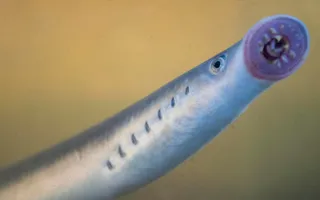Sea lamprey and our canals
Regarded as the most primitive fish, lamprey fossils have been found from the late Silurian and Devonian periods – approximately 450 million years ago. Sea lampreys have with no jaws but a circular sucking mouth with horny teeth.
They’re parasitic, meaning they attach to a living host species with their mouth sucker and feed on the body tissues. The young develop as larvae in the mud of larger rivers but migrate to the sea, where they spend their parasitic adult life. After a year or two, the adults return to the rivers to spawn and, soon after, die.
How to identify a sea lamprey
Adults are eel-like in size and shape, but they have no gill plates, paired fins or jaws. Instead, they have several breathing holes behind the eye. Their mouths are discs with numerous teeth, which attach and then rasp onto their host fish – giving them their nickname ‘vampire fish’.
Sea lampreys are a mottled brownish grey, which becomes orangey when spawning.
Lifecycle of a sea lamprey
Sea lampreys are migratory fish that lay their eggs in clean, sandy gravel in rivers. Young larvae then move to the soft marginal silt of the river to grow, feeding on the algae, bacteria and detritus in the mud.
When they’re ready, sea lampreys migrate to sea and feed parasitically on other fish by attaching themselves with their sucker-like mouths. Individuals detach from their host fish and then migrate back into freshwater to spawn, after which they die. During migration, lampreys don't feed. Instead, they focus their energy on getting to suitable spawning grounds.
Where to find sea lamprey
As juvenile sea lampreys spend their time in the mud and the adults are out at sea, you won’t see them in our inland waters until they migrate back to rivers in May and June. People often report seeing their carcasses.
Threats to sea lamprey
Sea lampreys are a rare and protected species in the UK covered by a number of designations:
- Listed on the International Union for Conservation of Nature (IUCN) Red List of Threatened Species
- Listed on Annex III of the Bern Convention and Annex II of the European Commission Habitats Directive (3)
- Special Area of Conservation (SAC) Annex II species at a number of sites
- Protected under the Salmon & Freshwater Fisheries Act, 1975 (as amended)
Sea lamprey are not fished for in the UK.





